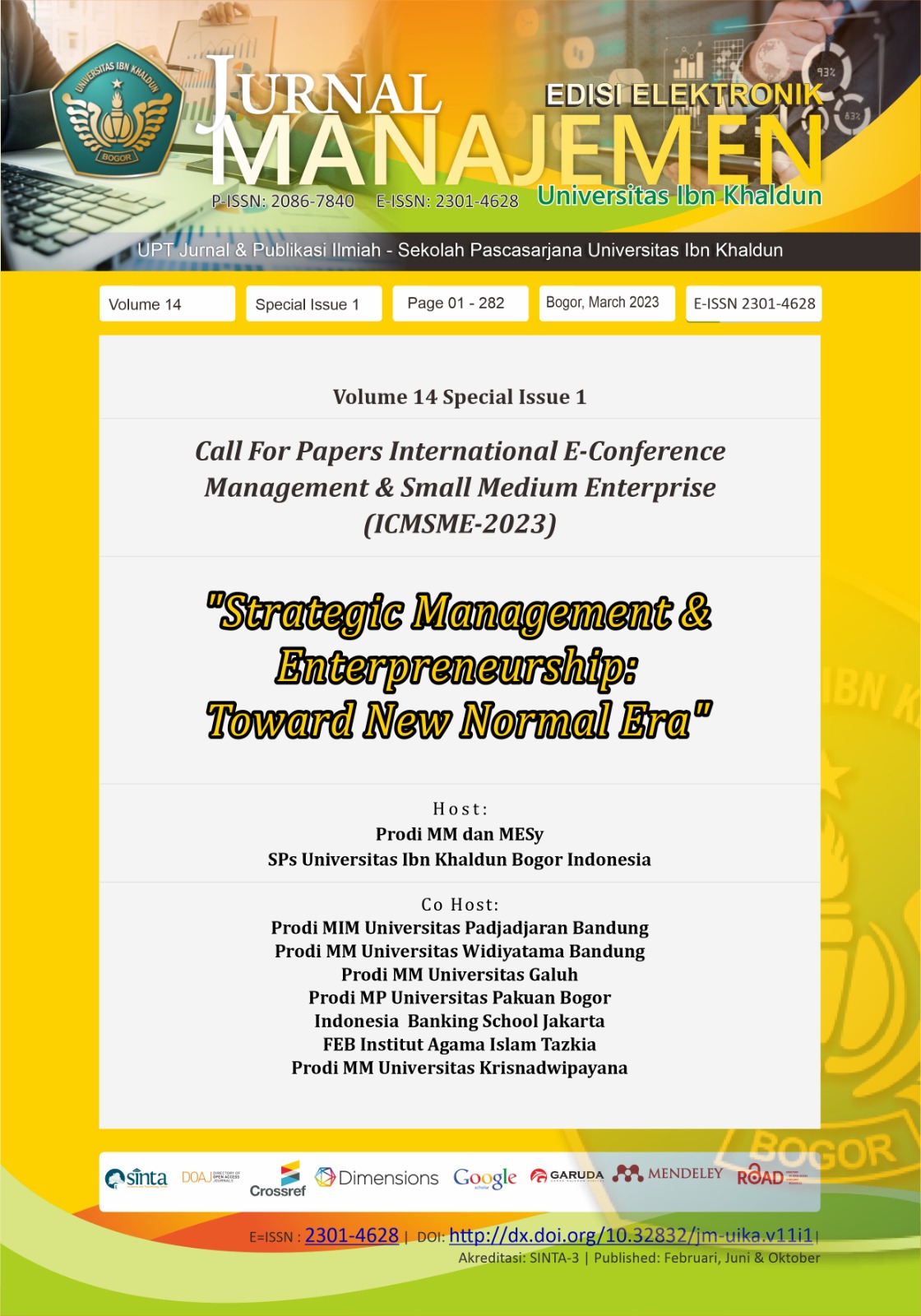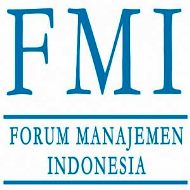Assessment Analysis of Bank Soundness Level using RGEC Approach in Banking Companies Listed on The IDX in 2019–2021
DOI:
https://doi.org/10.32832/jm-uika.v14i1.9410Kata Kunci:
Keywords, Bank Performance, IDX listed bank, RGECAbstrak
This study aims to analyze the soundness level of a bank using the Risk Profile, Good Corporate Governance, and Capital (RGEC) method in accordance with the Financial Authority Regulation Number 4/POJK.03/2016 in all banking sectors listed on the Indonesia Stock Exchange in 2019-2021. This research is descriptive research with a quantitative approach. The data used in this study is secondary data derived from the financial statements of the banking sector. The results showed that in 2019 there were nine banks that received a composite rating of one or very healthy, eighteen banks received a composite rating of two or healthy, ten banks received a composite rating of three or quite healthy, 5 banks received a composite rating of 4 or less healthy, and one bank that gets a rating of five or unhealthy. Then in 2020 there were nine banks that received a composite rating of one or very healthy, twenty one banks received a composite rating of two or healthy, six banks received a composite rating of three or quite healthy, one bank received a composite rating of five or unhealthy. In 2021, thirteen banks will receive a composite rating of one or very healthy, nineteen banks will receive a composite rating of two or healthy, four banks will receive a composite rating of three or quite healthy, six banks will receive a composite rating of four less healthy, one bank will receive a composite rating of five or not healthy. Nineteen banks will receive a composite rating of two or healthy, four banks will receive a composite rating of three or quite healthy, six banks will receive a composite rating of four unhealthy, and one bank will receive a composite rating of five or not healthy.
Keywords: Bank Performance, IDX listed bank, RGECReferensi
Amelia, E., & Aprilianti, A. C. (2018). Penilaian Tingkat Kesehatan Bank: Pendekatan CAMEL & RGEC (Studi pada Bank Maybank Syariah Indonesia Periode 2011-2016). Jurnal Akuntansi Dan Keuangan Islam, 6(2), 189–207.
Arifin, Ramly, R. Y., & Rahman, E. (2022). Pengukuran Tingkat Kesehatan Bank Menggunakan Metode Risk Profile, Good Corporate Govenance, Earning, Dan Capital. 5, 12–25.
Desyaningrum, R. (2021). Banyak Kasus Saldo di ATM Tiba-tiba Hilang Secara Misterius, Berikut Tips Terhindar dari Kejahatan Skimming. Grid.ID. https://www.grid.id/read/042708133/banyak-kasus-saldo-di-atm-tiba-tiba-hilang-secara-misterius-berikut-tips-terhindar-dari-kejahatan-skimming
Dewi, M. (2018). Analisis Tingkat Kesehatan Bank Dengan Menggunakan Pendekatan Rgec (Risk Profile, Good Corporate Governance, Earnings, Capital). Ihtiyath : Jurnal Manajemen Keuangan Syariah, 2(2). https://doi.org/10.32505/ihtiyath.v2i2.710
Hafiz, A. P. (2018). Penilaian Tingkat Kesehatan Bank Syariah dengan Metode CAMEL dan RGEC (Studi Pada Bank BNI Syariah Tahun 2011 - 2015). Ekonomi Syariah, 2(1), 66–83.
Iyelda, N., & Rimawan, M. (2022). Analisis Non Performing Loan ( NPL ) Dan Debt To Equity Ratio ( DER ) Terhadap Harga Saham Pada Perbankan Yang Listing Di Bursa Efek Indonesia. 1(3).
Maramis, P. A. (2020). Analisis Tingkat Kesehatan Bank Dengan Metode Rgec (Risk Profile, Good Corporate Governance, Earning, Capital) Pada Pt. Bank Mandiri (Persero) Periode 2015 - 2018. Jurnal Pembangunan Ekonomi Dan Keuangan Daerah, 20(3), 1. https://doi.org/10.35794/jpekd.28212.20.3.2020
Maspufah, H., & Haifah, H. (2022). Analisis Tingkat Kesehatan Bank Pada Bank BUMN di Indonesia (Bank BUMN Yang Terdaftar di BEI Tahun 2017-2019). Relasi: Jurnal Ekonomi, 18(2), 116–156. http://jurnal.itsm.ac.id/index.php/relasi/article/view/586%0Ahttp://jurnal.itsm.ac.id/index.php/relasi/article/download/586/542
Monoarfa, A., Murni, S., & Untu, V. N. (2020). Faktor-Faktor Yang Mempengaruhi ROA Studi Kasus Pada Bank Umum Syariah Yang Terdaftar Di BEI Periode 2014-2019. Jurnal EMBA: Jurnal Riset Ekonomi, Manajemen, Bisnis Dan Akuntansi Universitas Sam Ratulangi Manado, 8(3), 389–399.
Nufus, K., Triyanto, F., & Muchtar, A. (2019). Analisis Tingkat Kesehatan Bank Dengan Metode RGEC (Studi Kasus PT.Bank BNI (Persero) Tbk ). Jurnal SEKURITAS (Saham, Ekonomi, Keuangan Dan Investasi), 3(1), 76. https://doi.org/10.32493/skt.v3i1.3264
Paramartha dan Darmayanti, M. (2017). Penilaian Tingkat Kesehatan Bank Dengan Metode RGEC Pada PT Bank Mandiri,Tbk. E-jurnal Manajemen Unud Vol 6. E-Jurnal Manajemen Unud, 6(2), 948–974.
Pebrianto, F. (2021). Kasus Pemalsuan Deposito, BNI: Penerbitan Bilyet dan Transaksi Tak Libatkan Bank. Tempo.Co. https://bisnis.tempo.co/read/1506079/kasus-pemalsuan-deposito-bni-penerbitan-bilyet-dan-transaksi-tak-libatkan-bank
Pramana, K., & Artini, L. (2016). Analisis Tingkat Kesehatan Bank (Pendekatan Rgec) Pada Pt. Bank Danamon Indonesia Tbk. E-Jurnal Manajemen Universitas Udayana, 5(6), 3849–3878.
Rizal, F., & Humaidi, M. (2021). Analisis Tingkat Kesehatan Bank Syariah di Indonesia 2015-2020. Etihad: Journal of Islamic Banking and Finance, 1(1), 12–22. https://doi.org/10.21154/etihad.v1i1.2733
Safri, H., Prayoga, Y., & Hendry, R. S. M. (2020). Analysis The Bank's Health Level And Return Of Stock Of Banking In Indonesian Stock Exchange. 129–138.
Wulandari, P. (2022). Pengaruh Indikator Kesehatan Bank, Pertumbuhan Laba, Terhadap Return Saham Perbankan Putri. Jurnal Akuntansi, Manajemen Dan Ekonomi, 2(1), 68. https://doi.org/10.33474/jimmu.v5i1.6725
Unduhan
Diterbitkan
Cara Mengutip
Terbitan
Bagian
Lisensi
Authors who publish with this journal agree to the following terms:
- Authors retain copyright and grant the journal right of first publication with the work simultaneously licensed under a Creative Commons Attribution-NonCommercial-ShareAlike 4.0 International License that allows others to share the work with an acknowledgement of the work's authorship and initial publication in this journal.
- Authors can enter into separate, additional contractual arrangements for the non-exclusive distribution of the journal's published version of the work (e.g., post it to an institutional repository or publish it in a book), with an acknowledgement of its initial publication in this journal.
- Authors are permitted and encouraged to post their work online (e.g., in institutional repositories or on their website) prior to and during the submission process, as it can lead to productive exchanges, as well as earlier and greater citation of published work (See The Effect of Open Access).











